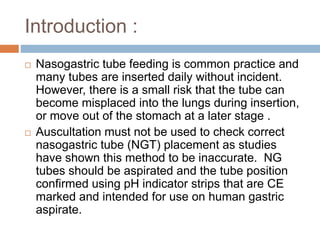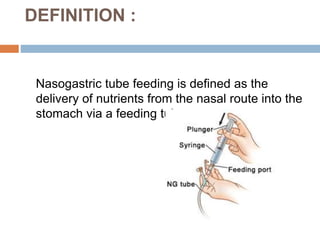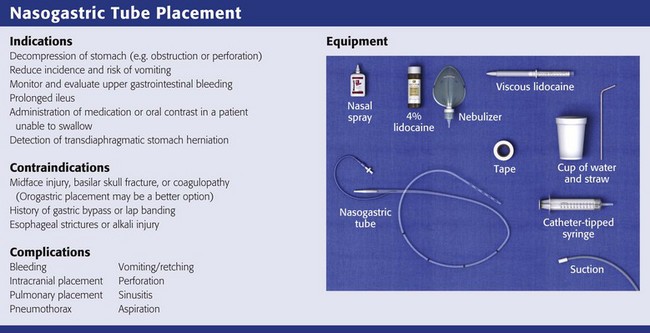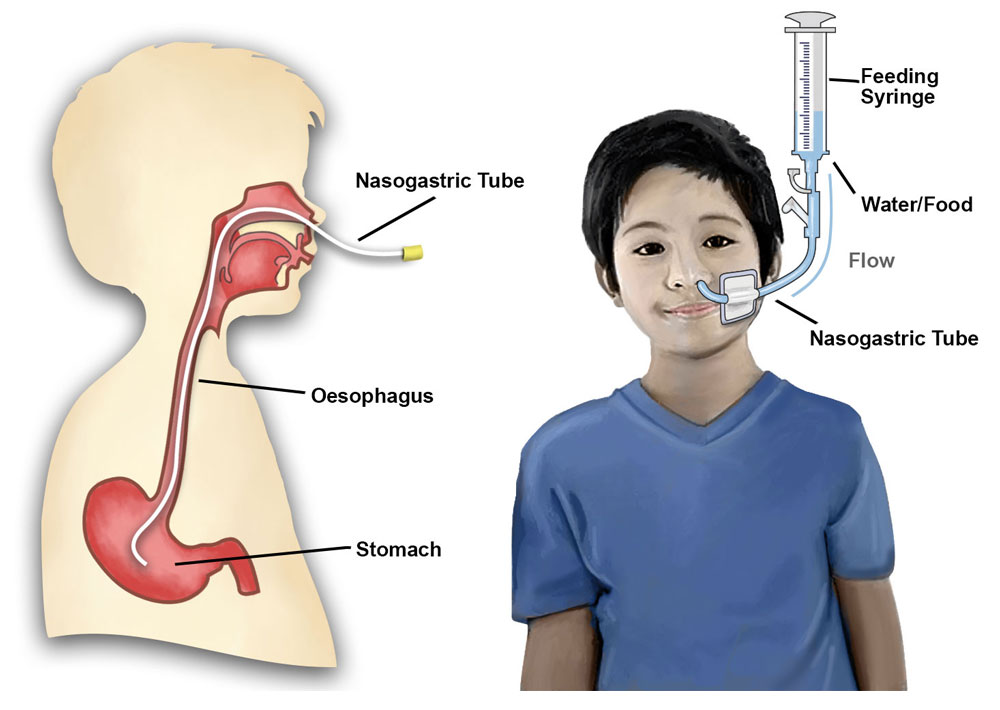What Describes an Advantage of Using a Nasogastric Tube
Use ETT with a slit in the lesser curvature as guide can consider using a bougie to place the ETT in the esophagus not essential and may be traumatic Use soft well lubricated. How many grams of protein per kilogram of body weight does this patient need.

Nasogastric Tube Insertion And Feeding
What describes an advantage of using a nasogastric tube to provide enteral tube feedings.

. Nasogastric intubation is not painful for most people though it does cause a certain amount of discomfort. Nasogastric tubes are part of the standard of care in treating intestinal obstruction and can also be used to provide nutritional support. Oral intubation using an endotracheal tube is still considered the airway of choice but there are situations where nasotracheal intubation is the better alternative.
May be less specific in localizing. Nasogastric tubes are indicated in cases of normal GI function. This may be done using aa split-tape method which involves tearing off about four inches of tape and splitting it lengthwise to about the halfway point.
Or removal of stomach contents. They also allow feeding to be initiated quickly as. A nasogastric or NG tube is a plastic tubing device that allows delivery of nutritionally complete feed directly into the stomach.
Whereas PEG tubes are long-term and it can make people complacent to remove. It has a high risk of aspiration What steps could a clinician take that would best reduce the risk of. Nasogastric tubes can also be used for diagnostic purposes since it is possible to collect gastric contents using an NG for laboratory analysis.
Insertion technique and confirming position. A nasogastric tube is irrigated regularly to determine and ensure the tubes patency. A drawback to using specialized or disease-specific formulas is that.
After creating tabs on the split ends tape. Discomfort for the patient. It is easy to insert and maintain.
What describes an advantage of using a nasogastric tube to provide enteral tube feedings. So nasogastric tubes are better especially since it keeps pushing things along and its shorter. It is easy to insert and maintain.
The nasogastric tube offers multifunctional support by way of providing comfort alleviating nausea and evacuating gastric fluid in patients with gastrointestinal stasis while. Expose patients to minimal ionizing radiation. Pain is usually prevented with local anesthesia and gel lubrication of the.
What describes a potential disadvantage of using a nasogastric tube for enteral feedings. Continuing Education Activity. Which best describes a disadvantage of using a nasogastric tube in a patient.
Intubation whether oral or. Nasogastric tubes can be used to aspirate. Discuss advantages and disadvantages of various enteral feeding routes ienasogastric tube NG gastrostomy tube GT and jejunostomy tube JT.
They stimulate digestive function are easy to insert and maintain and they allow for medication. Highly portable imaging modalities. 16 early online publication.
Et al 2009 Nasogastric tubes 1. Advantages and disadvantages of a. Studies identified 1 a wide range of refeeding regimes depending on country settings and the reason for initiation.
2 standard practice is to introduce Nasogastric feeds. They use and stimulate digestive functions and are easy to insert and maintain. It is passed via the nose into.
This is the first in a two-part unit on. It will help release any formula stuck to the inside of the tube. Highly sensitive and specific in localizing nasogastric tubes.
Nasogastric tubes are indicated in cases of normal GI function. What best describes an advantage of using a continuous.

Nasogastric Tube Insertion And Feeding

Tracheostomy And Feeding Tubes Tracheostomy Education


No comments for "What Describes an Advantage of Using a Nasogastric Tube"
Post a Comment